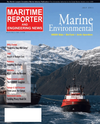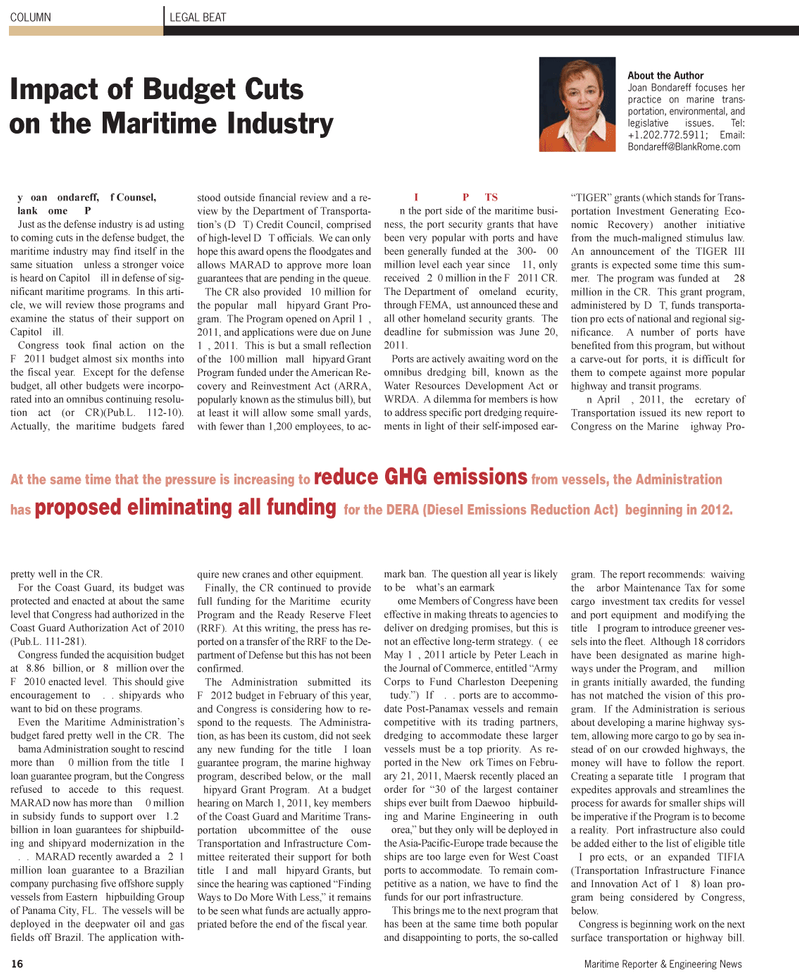
Page 16: of Maritime Reporter Magazine (July 2011)
The Green Ship Edition
Read this page in Pdf, Flash or Html5 edition of July 2011 Maritime Reporter Magazine
16Maritime Reporter & Engineering News LEGAL BEAT COLUMNImpact of Budget Cuts on the Maritime Industryy oan ondareff, f Counsel, lank ome P Just as the defense industry is adusting to coming cuts in the defense budget, the maritime industry may find itself in the same situationunless a stronger voice is heard on Capitol ill in defense of sig- nificant maritime programs. In this arti- cle, we will review those programs and examine the status of their support on Capitol ill. Congress took final action on the F2011 budget almost six months into the fiscal year. Except for the defense budget, all other budgets were incorpo- rated into an omnibus continuing resolu- tion act (or CR)(Pub.L. 112-10). Actually, the maritime budgets fared pretty well in the CR. For the Coast Guard, its budget was protected and enacted at about the samelevel that Congress had authorized in the Coast Guard Authorization Act of 2010 (Pub.L. 111-281). Congress funded the acquisition budget at 8.86 billion, or 8 million over the F2010 enacted level. This should give encouragement to .. shipyards who want to bid on these programs. Even the Maritime Administration?s budget fared pretty well in the CR. The bama Administration sought to rescind more than 0 million from the title I loan guarantee program, but the Congress refused to accede to this request.MARAD now has more than 0 million in subsidy funds to support over 1.2 billion in loan guarantees for shipbuild- ing and shipyard modernization in the .. MARAD recently awarded a 21 million loan guarantee to a Braziliancompany purchasing five offshore supply vessels from Eastern hipbuilding Group of Panama City, FL. The vessels will be deployed in the deepwater oil and gas fields off Brazil. The application with- stood outside financial review and a re- view by the Department of Transporta- tion?s (DT) Credit Council, comprised of high-level DT officials. We can only hope this award opens the floodgates and allows MARAD to approve more loan guarantees that are pending in the queue. The CR also provided 10 million for the popular mall hipyard Grant Pro- gram. The Program opened on April 1, 2011, and applications were due on June1, 2011. This is but a small reflection of the 100 million mall hipyard Grant Program funded under the American Re- covery and Reinvestment Act (ARRA, popularly known as the stimulus bill), but at least it will allow some small yards, with fewer than 1,200 employees, to ac- quire new cranes and other equipment. Finally, the CR continued to provide full funding for the Maritime ecurity Program and the Ready Reserve Fleet (RRF). At this writing, the press has re- ported on a transfer of the RRF to the De-partment of Defense but this has not been confirmed. The Administration submitted its F2012 budget in February of this year, and Congress is considering how to re- spond to the requests. The Administra- tion, as has been its custom, did not seekany new funding for the title I loan guarantee program, the marine highway program, described below, or the mall hipyard Grant Program. At a budget hearing on March 1, 2011, key members of the Coast Guard and Maritime Trans- portation ubcommittee of the ouse Transportation and Infrastructure Com- mittee reiterated their support for bothtitle I and mall hipyard Grants, but since the hearing was captioned ?Finding Ways to Do More With Less,? it remains to be seen what funds are actually appro-priated before the end of the fiscal year. I PTS n the port side of the maritime busi- ness, the port security grants that have been very popular with ports and have been generally funded at the 300-00 million level each year since 11, only received 20 million in the F2011 CR. The Department of omeland ecurity, through FEMA, ust announced these and all other homeland security grants. The deadline for submission was June 20, 2011. Ports are actively awaiting word on the omnibus dredging bill, known as the Water Resources Development Act or WRDA. A dilemma for members is how to address specific port dredging require- ments in light of their self-imposed ear- mark ban. The question all year is likely to bewhat?s an earmark ome Members of Congress have been effective in making threats to agencies to deliver on dredging promises, but this is not an effective long-term strategy. (ee May 1, 2011 article by Peter Leach in the Journal of Commerce, entitled ?Army Corps to Fund Charleston Deepeningtudy.?) If .. ports are to accommo- date Post-Panamax vessels and remain competitive with its trading partners, dredging to accommodate these larger vessels must be a top priority. As re- ported in the New ork Times on Febru- ary 21, 2011, Maersk recently placed anorder for ?30 of the largest container ships ever built from Daewoo hipbuild- ing and Marine Engineering in outh orea,? but they only will be deployed in the Asia-Pacific-Europe trade because the ships are too large even for West Coast ports to accommodate. To remain com- petitive as a nation, we have to find the funds for our port infrastructure.This brings me to the next program that has been at the same time both popularand disappointing to ports, the so-called?TIGER? grants (which stands for Trans- portation Investment Generating Eco- nomic Recovery)another initiative from the much-maligned stimulus law. An announcement of the TIGER III grants is expected some time this sum- mer. The program was funded at 28 million in the CR. This grant program, administered by DT, funds transporta- tion proects of national and regional sig- nificance. A number of ports have benefited from this program, but without a carve-out for ports, it is difficult for them to compete against more popularhighway and transit programs. n April , 2011, the ecretary of Transportation issued its new report to Congress on the Marine ighway Pro- gram. The report recommends: waiving the arbor Maintenance Tax for some cargo investment tax credits for vessel and port equipment and modifying the title I program to introduce greener ves- sels into the fleet. Although 18 corridors have been designated as marine high- ways under the Program, and million in grants initially awarded, the funding has not matched the vision of this pro-gram. If the Administration is serious about developing a marine highway sys- tem, allowing more cargo to go by sea in- stead of on our crowded highways, the money will have to follow the report. Creating a separate title I program that expedites approvals and streamlines the process for awards for smaller ships will be imperative if the Program is to become a reality. Port infrastructure also could be added either to the list of eligible titleI proects, or an expanded TIFIA (Transportation Infrastructure Finance and Innovation Act of 18) loan pro- gram being considered by Congress,below. Congress is beginning work on the next surface transportation or highway bill. About the AuthorJoan Bondareff focuses her practice on marine trans-portation, environmental, and legislative issues. Tel: +1.202.772.5911; Email:[email protected] At the same time that the pressure is increasing to reduce GHG emissions from vessels, the Administration has proposed eliminating all funding for the DERA (Diesel Emissions Reduction Act) beginning in 2012.

 15
15

 17
17
